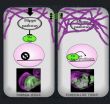(Press-News.org) A group of scientists at the Instituto Gulbenkian de Ciência, in Portugal, have uncovered a surprising link between the cell's skeleton and organ size. The team, led by Florence Janody, show in the journal Development(*), that one of the proteins that regulates the skeleton of the cell also acts to blocks activation of genes that promote cell survival and proliferation. Their findings have implications for cancer research, as they add to the puzzle of understanding how proliferation genes are abnormally activated, often leading to tumours.
During development of an embryo, cells proliferate and organs grow. This process is tightly regulated, at several levels, to ensure that organs do not outgrow the body they are in. One of the key regulators in this process is the Hippo complex of proteins - first identified in the fruit fly Drosophila melanogaster. Mutant flies, in which this complex is defective are larger than their counterparts - they are hippopotamus-like. A search for analogous genes uncovered a similar role for the Hippo complex in mammals - organs grow larger than they should. In adults, this abnormal and untimely growth often leads to tumour formation.
A flurry of papers has shown that the Hippo complex itself is regulated by a range of signaling inputs within the cell. Florence Janody's group identified a new, and unexpected input: the cell skeleton (called cytoskeleton), in particular one of its proteins, the actin-capping protein.
Using Drosophila larvae, the IGC team showed that when the actin-capping proteins are inactive, there is overgrowth of tissue in the area that will become the adult wing. This growth is reminiscent of tumour formation. The researchers dissected the different steps in the process that lead to abnormal growth. Inactivating actin-capping proteins leads to accumulation of actin, a major component of the cytoskeleton; this reduces the activity of the Hippo complex, leaving another protein, Yorkie, free to act on the DNA in the nucleus, turning on proliferation genes.
The cytoskeleton serves several functions in a cell: it provides structure, motility (allows cells to move, change shape and divide) and membrane traffic (transport of proteins and other large molecules within the cell). The actin protein forms cables that crisscross the cell. The cables are constantly being elongated and shortened at their ends. The actin-capping proteins are involved in this process.
In Florence's words, ' What we've revealed is that the cytoskeleton needs to be very tightly regulated within the cell, to prevent abnormal growth in the larvae. Since Hippo is also turned on in the adult and in mammals, we believe these findings provide insights into how this process may be manipulated in human cells, with a view to preventing tumour formation, or blocking its progression'.
INFORMATION:
This research was carried out the at the IGC with funding from the Fundação para a Ciência e a Tecnologia (Portugal).
Scientists uncover role for cell scaffold in tumor formation
Fruit fly reveals surprising link
2011-06-07
ELSE PRESS RELEASES FROM THIS DATE:
Children, Families Invited to Exhibit Opening at Nana's Fire and Safety School
2011-06-07
Nana's Fire and Safety School will have its grand opening of Nana's Interactive Exhibit inside the Permian Basin Regional Training Center on June 11, 2011 from 10:00am to 2:00pm.
"The interactive exhibit is the next stage of growth toward our goal to teach children how to be safe," said Martha "Nana" Chapman. "We want everyone to come out and see how Nana's Fire and Safety School came to be, show families the reason to be vigilant with their children's safety, and share our vision for the future."
Nana's Fire and Safety School and the ...
Scientists unlock potential of frog skin to treat cancer
2011-06-07
Scientists at Queen's University Belfast have discovered proteins in frog skins which could be used to treat cancer, diabetes, stroke and transplant patients by regulating the growth of blood vessels.
The award-winning research, led by Professor Chris Shaw at Queen's School of Pharmacy, has identified two proteins, or 'peptides', which can be used in a controlled and targeted way to regulate 'angiogenesis' – the process by which blood vessels grow in the body. The discovery holds the potential to develop new treatments for more than seventy major diseases and conditions ...
Prominent Congressman Visits WIPP and Speaks with Carlsbad's Community Leaders
2011-06-07
Carlsbad, NM and the Waste Isolation Pilot Plant (WIPP) received a visit this past Saturday from Representative James Clyburn (SC, 6th Dist.), a prominent member of the U.S. Congress. Congressman Clyburn, the Assistant Democratic Leader in the U.S. House of Representatives and a member of the Congress since 1993, is the leadership liaison to the Appropriations Committee and one of the Democratic Caucus' primary liaisons to the White House. Clyburn spent the day in Carlsbad, NM touring the WIPP site and speaking with community leaders. "I had a very productive and enlightening ...
Higher density means world forests are capturing more carbon
2011-06-07
Contact: Joseph Bonner
bonnerj@rockefeller.edu
212-327-8998
Rockefeller University
Terry Collins
tc@tca.tc
416-538-8712
416-878-8712 (mob)
Higher density means world forests are capturing more carbon
Forests in many regions are becoming larger carbon sinks thanks to higher density, U.S. and European researchers say in a new report.
In Europe and North America, increased density significantly raised carbon storage despite little or no expansion of forest area, according to the study, led by Aapo Rautiainen of the University of Helsinki, Finland, and ...
Research examines how to apply conductive nanocoatings to textiles
2011-06-07
Imagine plugging a USB port into a sheet of paper, and turning it into a tablet computer. It might be a stretch, but ideas like this have researchers at North Carolina State University examining the use of conductive nanocoatings on simple textiles – like woven cotton or even a sheet of paper.
"Normally, conductive nanocoatings are applied to inorganic materials like silicon. If we can find a way to apply them to textiles – cheap, flexible materials with a contorted surface texture – it would represent a cost-effective approach and framework for improving current and ...
A study analyzes the role of universities and technology institutes in firm innovation
2011-06-07
This release is available in Spanish.
The objective of this research work focuses on analyzing the functioning of the technology centers and evaluating the results obtained in fomenting innovation and competitivity in companies and universities. In the majority of developed countries, technology institutes are considered an important element of national and regional technology structure; these companies offer a wide array of services, ranging from applied research and technological development to other support services, such as consulting, diagnostic and technical assistance. ...
Support for Massachusetts landmark health reform law rises in 2011
2011-06-07
A new poll by the Harvard School of Public Health and The Boston Globe finds 63% of Massachusetts residents support the health care reform legislation enacted in 2006, 21% oppose it while 6% are not sure and 9% have not heard or read about the law. The percentage of residents supporting the law has increased since a 2009 poll (53%).[1] Support for the law varied by party affiliation, with 77% of Democrats, 60% of Independents, and 40% of Republicans saying they support the legislation. The poll was conducted May 24-26, 2011.
Despite a difficult financial environment ...
Red Bull Takes 12,500 Square Feet at Southern California Logistics Centre
2011-06-07
Stirling Capital Investments has secured a five-year lease for a 12,500-square-foot industrial property with international beverage company Red Bull. The facility, located at 13644 George Blvd in Victorville within Southern California Logistics Centre (SCLC), will serve as a regional warehouse and distribution center for Red Bull's internationally renowned line of energy drinks.
"SCLC continues to grow as a premier destination for multinational food and beverage companies," said Brian Parno, chief operating officer of Stirling Development, the managing partner ...
Experts recommend screening for vitamin D deficiency in at-risk populations
2011-06-07
Today, The Endocrine Society released "Evaluation, Treatment, and Prevention of Vitamin D Deficiency: An Endocrine Society Clinical Practice Guideline." The clinical practice guideline (CPG) is published in the July 2011 issue of the Journal of Clinical Endocrinology & Metabolism (JCEM), a publication of The Endocrine Society.
The major source of vitamin D for children and adults is exposure to natural sunlight as very few foods naturally contain or are fortified with vitamin D. Vitamin D deficiency is common throughout the world and results in abnormalities of calcium, ...
The faithless side of suicide bombing
2011-06-07
Terrorist groups bend the rules of 'true' Islam to justify the use of female suicide bombers, according to Margaret Gonzalez-Perez from Southeastern Louisiana University in the US. Her paper traces the development of radical Islamic doctrine over time, highlights how it deviates from mainstream Islam, and identifies the building blocks that have culminated in Jihadi female suicide bombers. According to Gonzalez-Perez, "Radical Islam reinterprets, and even misinterprets Islamic jurisprudence, as a tool to legitimize female suicide bombers." Her findings are published online ...
LAST 30 PRESS RELEASES:
The perfect plastic? Plant-based, fully saltwater degradable, zero microplastics
Bias in data may be blocking AI’s potential to combat antibiotic resistance
Article-level metrics would provide more recognition to most researchers than journal-level metrics
Satiety’s little helper: Protein that supports appetite regulating protein identified
UF dives deep into predicting storm damage with computer models
A stormy ocean voyage yields insights on the global carbon cycle
Scientists identify first non-coding gene that controls cell size
Demonstration of altermagnetism in RuO₂ thin films -- A new magnetic material for the AI era
Penn researchers awarded $25M to conduct trial using smartphones to fight heart disease
PCORI awards funding for new patient-centered healthcare research
Exploring the origins of the universe: 145 low-noise amplifiers complete ALMA telescopes
Empress cicada wings help illuminate molecular structure
Using sound waves to detect helium
Time burden in patients with metastatic breast and ovarian cancer from clinic and home demands
Researchers discover bias in AI models that analyze pathology samples
Scientists ID potential way to prevent brain injuries from triggering Alzheimer's
MASTER 2nd Open Call: Execution period kick-off
Algae for health in food and pharma
Advanced microrobots driven by acoustic and magnetic fields for biomedical applications
Chicago health information leader recognized for raising CPR readiness and blood pressure awareness
The Intimate Animal, a new book from Kinsey Institute Executive Director Dr. Justin Garcia
When blue-collar workers lose union protection, they try self-employment
New video dataset to advance AI for health care
MEA-based graph deviation network for early autism syndrome signatures in human forebrain organoids
New modeling approach sheds light on rare gut disease
Study documents potentially hazardous flame retardants in firefighter gear
Can certain bacteria regulate aging of the immune system and its related alterations?
AI model helps diagnose often undetected heart disease from simple EKG
There are fewer online trolls than people think
Cell membrane fluctuations produce electricity
[Press-News.org] Scientists uncover role for cell scaffold in tumor formationFruit fly reveals surprising link


